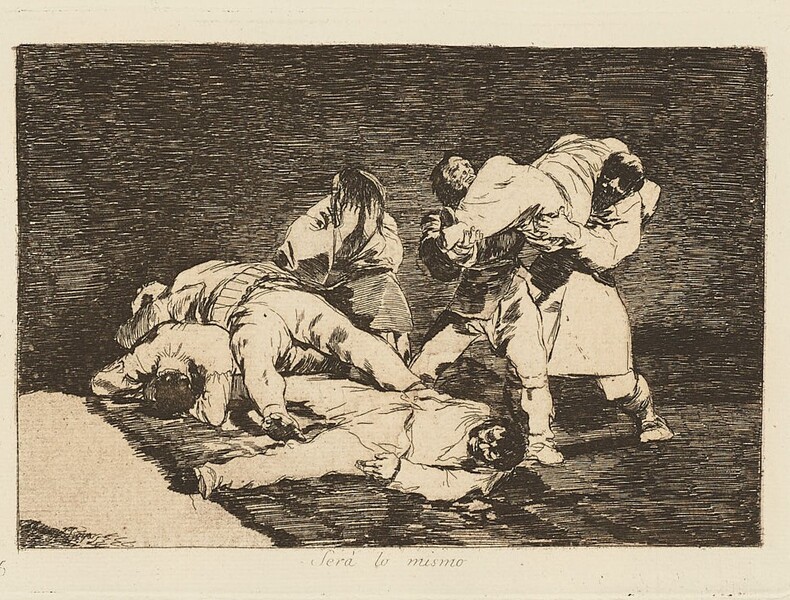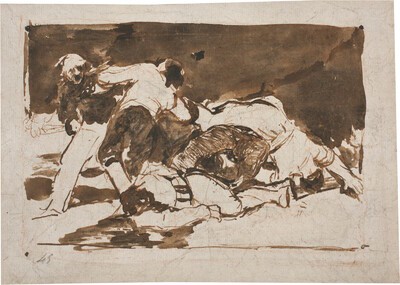- Cronología
- Ca. 1810 - 1812
- Dimensiones
- 148 x 218 mm
- Técnica y soporte
- Etching and burnished lavis
- Reconocimiento de la autoría de Goya
- Undisputed work
- Ficha: realización/revisión
- 01 Dec 2010 / 02 Jun 2023
- Inventario
- 225
Goya (lower left-hand corner), 25 (lower left-hand corner).
See Sad presentiments of what must come to pass.
The second artist's proof shows that Goya etched his signature into the lower left-hand corner of the plate.
The title was handwritten on the print by Goya on the first and only series that we know was produced at the time of its creation, which the artist gave to his friend Agustín Ceán Bermúdez. Therefore, the title was etched into the plate at a later date and left unchanged as of the first edition of the Disasters of War printed by the San Fernando Royal Academy of Fine Arts in Madrid in 1863, after the printing of the series in the possession of Ceán Bermúdez.
There is a surviving preparatory drawing for this print which is housed in the Prado Museum in Madrid.
In this print Goya depicts a scene that is probably taking place at night, given the extreme darkness of the setting. The print shows men trying to carry away some corpses. On the right, two men are holding a body wrapped in a white sheet that has been given great pictorial depth. Next to these two men in the middle ground, a figure covered from head to foot - perhaps a female relative of one of the dead - covers her face with her hands. On the left-hand side of the print are three more dead bodies.
The title of the print highlights the futility of moving the bodies, since taking them somewhere else will be no different to leaving them where they are: there is nothing that can be done.
This image must be understood in the context of print no. 22,All This and More, and nº 23,The Same Elsewhere, in which the artist also represents open spaces littered with piles of corpses. In both cases, the scenes have a markedly horizontal composition that transmits a strong sensation of stillness and peace, as well as a sense of sepulchral silence.
The moving of corpses after a battle is a theme also dealt with by Fernando Brambila (Cassano d'Adda, 1763-Madrid, 1832) and Juan Gálvez (Mora, Toledo, 1774-Madrid, 1847) in the print entitled Second Ruin of the Interior of the Church of the General Hospital (Ruina segunda del interior de la yglesia del hospital general) (ca. 1812-1813, Lázaro Galdiano Museum, Madrid).
The plate is stored in the National Chalcography (cat. 272)
-
Goya and his timesThe Royal Academy of ArtsLondon1963cat. 66cat. 237
-
De grafiek van GoyaRijksmuseum RijksprentenkabinetAmsterdam1970from November 13th 1970 to January 17th 1971cat. 68
-
Francisco de GoyaMuseo d'Arte ModernaLugano1996exhibition celebrated from September 22nd to November 17th.cat. 21
-
Francisco Goya. Sein leben im spiegel der graphik. Fuendetodos 1746-1828 Bordeaux. 1746-1996Galerie KornfeldBern1996from November 21st 1996 to January 1997cat. 109
-
Ydioma universal: Goya en la Biblioteca NacionalBiblioteca NacionalMadrid1996from September 19th to December 15th 1996cat. 218
-
Francisco Goya. Capricci, follie e disastri della guerraSan Donato Milanese2000Opere grafiche della Fondazione Antonio Mazzottacat. 101
-
Goya. Opera graficaPinacoteca del Castello di San GiorgioLegnano2006exhibition celebrated from December 16th 2006 to April 1st 2007p. 61
-
Goya et la modernitéPinacothèque de ParisParís2013from October 11st 2013 to March 16th 2014cat. 60
-
2022
-
Goya, grabadorMadridBlass S.A.1918cat. 123
-
Goya engravings and lithographs, vol. I y II.OxfordBruno Cassirer1964cat. 141
-
Vie et ouvre de Francisco de GoyaParísOffice du livre1970cat. 1027
-
Catálogo de las estampas de Goya en la Biblioteca NacionalMadridMinisterio de Educación y Cultura, Biblioteca Nacional1996cat. 219
-
ParísPinacoteca de París2013p. 130
-
Goya. In the Norton Simon MuseumPasadenaNorton Simon Museum2016pp. 114-151
-
Museo de Bellas Artes de Badajoz y Diputación de Badajoz2022p. 62

